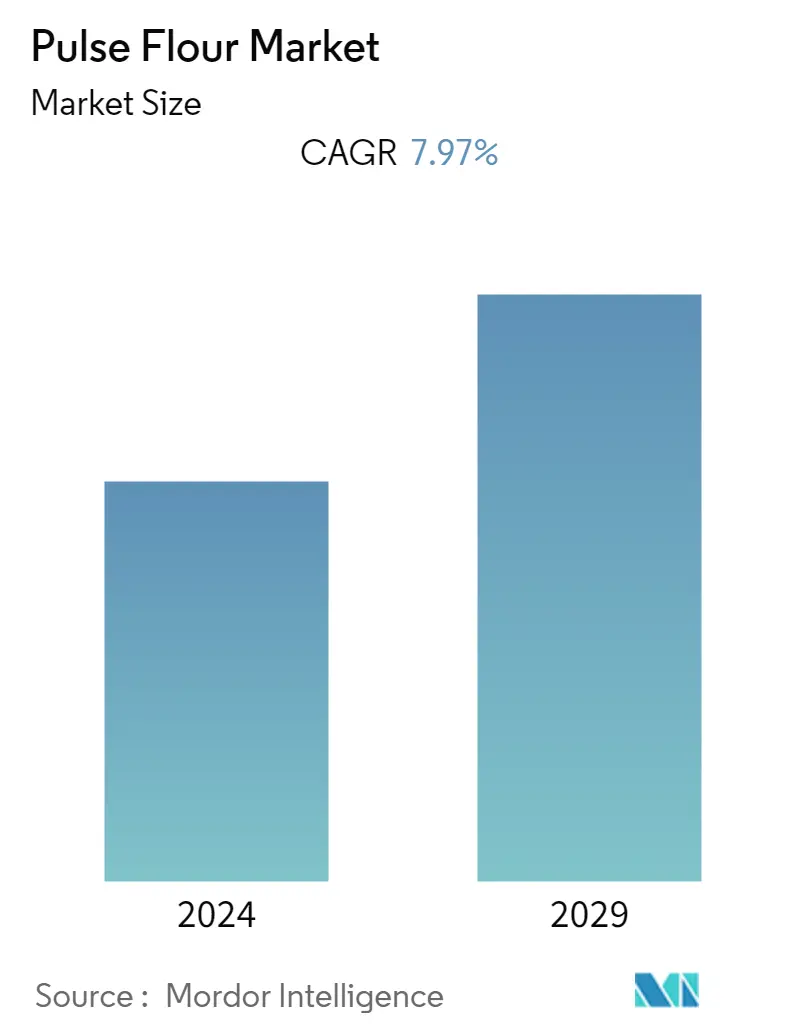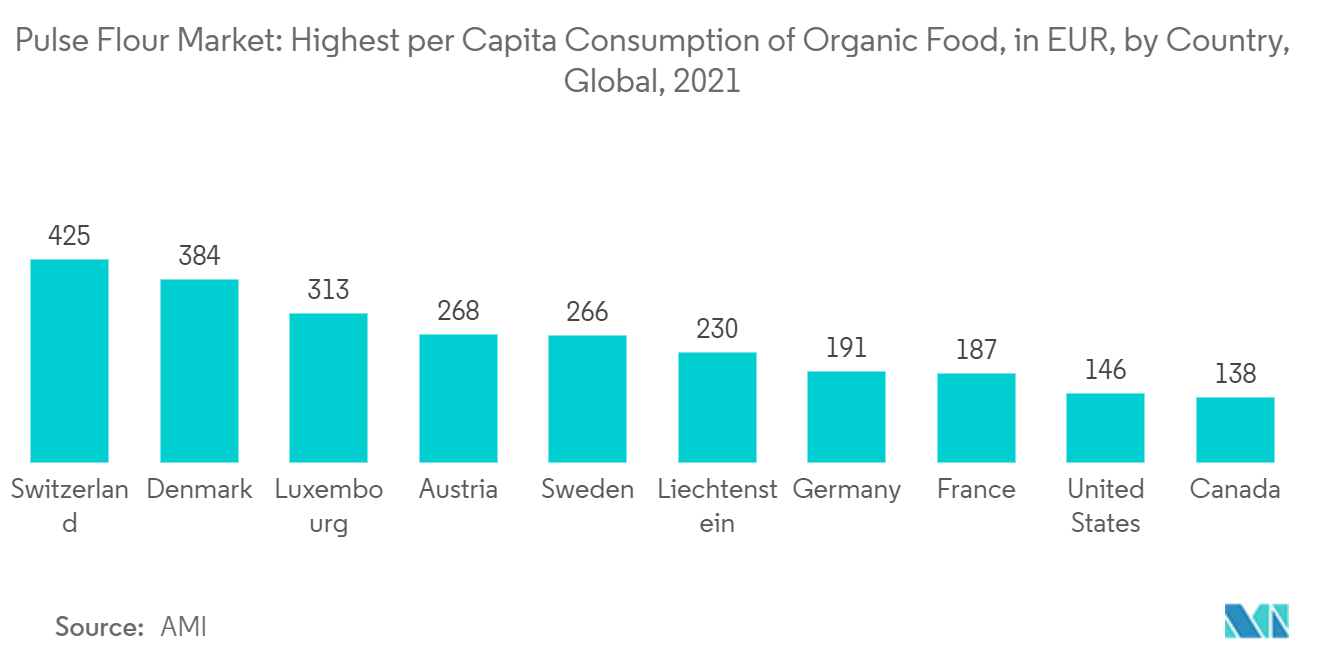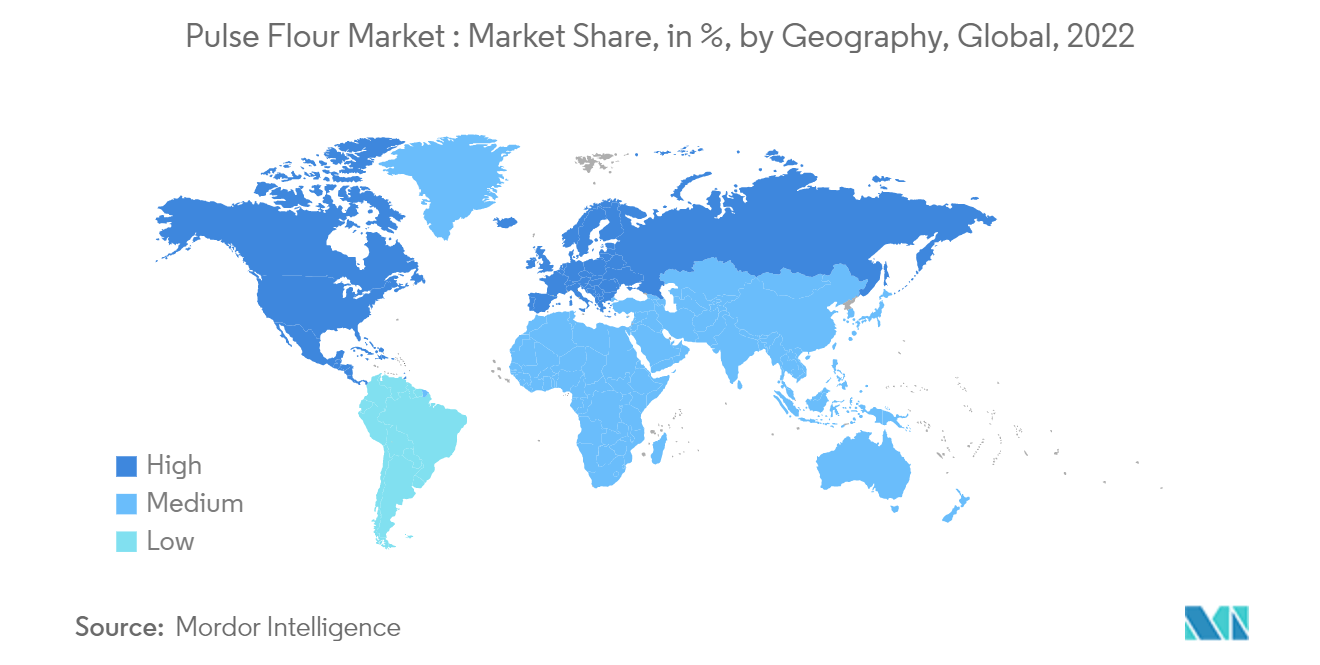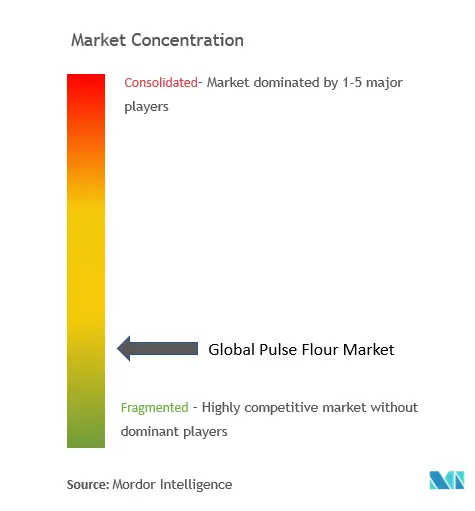Pulse Flour Market Size

| Study Period | 2019 - 2029 |
| Base Year For Estimation | 2023 |
| CAGR | 7.97 % |
| Fastest Growing Market | South America |
| Largest Market | North America |
| Market Concentration | Low |
Major Players.webp)
*Disclaimer: Major Players sorted in no particular order |
Pulse Flour Market Analysis
The global pulse flour market is projected to record a CAGR of 7.97% over the next five years.
Pulse flour, a gluten-free functional ingredient, is being driven by its increasing demand in various food and animal feed industries. The high demand for pulse flour is majorly due to its higher nutritional properties as compared to other grain flour. Government initiatives for pulse harvesting are also resulting in increased growth and volume of pulses, further driving the market. The growth of the pulse flour market is witnessing a huge boost with the rising number of new pulse flour-based products that have been launched in North America and Europe over the past few years. For instance, in 2021, Limagrain Ingredient introduced Uniflour 35501, a new heat-treated pea flour, to meet the needs of calves and piglets for milk replacers.
Improvements in the food processing and food service sectors, along with improvements in the world's agricultural growth over the past ten years, have created new opportunities for pulse flours and have supported market expansion over the years. The desire for clean-label food products in the market is causing it to flourish even more. The Pulse Flour Market is anticipated to continue expanding significantly due to rising consumer expenditure on health-improving products, rising crop yield, globalization, changing lifestyles, and rising personal disposable income.
Pulse Flour Market Trends
Growing Demand for Organic and Gluten-free Flour
The rise in consumer awareness regarding gluten sensitivity has propelled the demand for gluten-free flour globally. Pulse flour, being a gluten-free ingredient, has seen an increased preference among consumers in recent years. Although the prevalence of the celiac disease is approximately moderate globally, the number of Americans giving up eating gluten has increased over the last decade. According to the Mayo Clinic, 3.1 million Americans follow a gluten-free diet, and 72% of them are classified as PWAGs or 'people without celiac disease avoiding gluten.' Therefore, manufacturers are offering a wide range of gluten-free products using gluten-free ingredients, such as pulse flour, which range from low to high nutritional value. Further, companies have been extensively involved in the research and development of such products to cater to organic and gluten-free industries and thus, remain competitive in the market. For instance, Limagrain Céréales Ingrédients upgraded its Nutrition and Taste & Color solutions with an organic pulses flour range.
Additionally, there has been a significant increase in the demand for natural/organic/good-for-health food products among consumers in recent years, as they are becoming more aware of the adverse health effects associated with the consumption of various artificial food ingredients. Moreover, clean labeling is no longer a trend but has become a high-rated consumer demand that the global food industry is responding to by putting additional emphasis on these aspects during processing a food product. Similarly, various organizations' awareness programs and research projects have also largely promoted the use of organic ingredients extracted from plant sources in food and beverage products, as food safety is one of the primary concerns. For instance, in India, a new campaign, '#TowardsHealthyEatingwith the aim,' was launched by Organic India to promote healthy eating practices amongst children (in 2022). Also, companies like Walmart announced to promote natural ingredients which is one of their goals by 2025. According to the Walmart Sustainability Hub, the retailer started working with suppliers to remove certified synthetic ingredients in food products, which consumers do not expect to see. Therefore, all the above mentioned factors are expected to drive the market during the forecast period.

North America Holds the Largest Market Share
Lifestyle shifts and increasing environmental awareness, such as veganism and consumption of non-GMO, gluten-free products, and the growing demand for natural and healthy ingredients have been driving the pulse flour market. As a result the major players are investing in product innovation and research and development (R&D) in order gain consumer attention and to maintain their position in the market. Further expansion of the product portfolio enhance these companies' positions in the market. For instance, Nutriati launched a proprietary chickpea ingredient for plant-based meats, named Artesa Textured Pulse Protein, which is a combination of Nutriati's Artesa chickpea flour and carefully sourced yellow pea protein that is manufactured following the tightly-controlled final ingredient specifications. The key driving factor for the market is the increased demand for pulse flour in bakery applications, as it is gluten-free, offers better hydration and softness, and nutritionally enriches the products.
Chickpeas are an excellent source of proteins, vitamins, minerals, and carbs and have a lot of dietary fiber. Moreover, chickpea flour has a number of health benefits, including improved digestion, weight management, lowered heart attack risk, and blood sugar stabilization. Several factors have contributed to the increase in chickpea demand. The market is likely to witness growth as a result of the increasing usage of pulse flour in the production of soups, sauces, dips, and spreads. The demand for chickpea flour is anticipated to be driven by increasing consumer health consciousness and an increase in the use of chickpea flour in the region.

Pulse Flour Industry Overview
The market studied is highly competitive in nature due to the presence of domestic and international players. Some of the key players in the pulse flour market globally include Archer Daniels Midland Company, AGT Foods and Ingredients, Anchor Ingredients, Avena Foods, and Ingredion Incorporated Food Company. The key players are majorly focusing on product development and innovation to meet consumers' needs by offering a variety in taste and in the product quality to maintain premiumization.
Pulse Flour Market Leaders
-
AGT Foods and Ingredients
-
Anchor Ingredients
-
Avena Foods
-
Ingredion Incorporated Food company
-
Archer-Daniels-Midland Company
*Disclaimer: Major Players sorted in no particular order

Pulse Flour Market News
- In September 2021, Ingredion launched pulse-based ingredient solutions, including Homecraft Prista P 101 pea flour, for plant-protein-based applications, including instant and ready-to-eat (RTE) products.
- In May 2021, Limagrain Ingredient introduced Uniflour 35501, a new heat-treated pea flour, to meet the needs of calves and piglets for milk replacers.
- In June 2020, Buhler collaborated with the Food Application Center (FAC) in Minnesota, United States, where it will hold discussions with food and feed industry customers, startups, members of academia, and other partners to develop sustainable solutions for the North American market. Moreover, Bühler is expected to utilize the new state-of-the-art application center to turn the crops of raw materials, such as pulses, ancient grains, beans, oats, and others, into flours, snacks, extruded products, and even plant-based protein products.
Pulse Flour Market Report - Table of Contents
1. INTRODUCTION
- 1.1 Study Assumptions and Market Definition
- 1.2 Scope of the Study
2. RESEARCH METHODOLOGY
3. EXECUTIVE SUMMARY
4. MARKET DYNAMICS
- 4.1 Market Drivers
- 4.2 Market Restraints
-
4.3 Porter's Five Forces Analysis
- 4.3.1 Bargaining Power of Suppliers
- 4.3.2 Bargaining Power of Consumers
- 4.3.3 Threat of New Entrants
- 4.3.4 Threat of Substitute Products
- 4.3.5 Intensity of Competitive Rivalry
5. MARKET SEGMENTATION
-
5.1 Category
- 5.1.1 Organic Flour
- 5.1.2 Conventional Flour
-
5.2 Product Type
- 5.2.1 Bean
- 5.2.2 Chickpea
- 5.2.3 Lentil
- 5.2.4 Pea
-
5.3 Application
- 5.3.1 Bakery
- 5.3.2 Extruded Snacks
- 5.3.3 Pet Food and Feed
- 5.3.4 Other Applications
-
5.4 Geography
- 5.4.1 North America
- 5.4.1.1 United States
- 5.4.1.2 Canada
- 5.4.1.3 Mexico
- 5.4.1.4 Rest of North America
- 5.4.2 Europe
- 5.4.2.1 United Kingdom
- 5.4.2.2 France
- 5.4.2.3 Germany
- 5.4.2.4 Russia
- 5.4.2.5 Italy
- 5.4.2.6 Spain
- 5.4.2.7 Rest of Europe
- 5.4.3 Asia-Pacific
- 5.4.3.1 China
- 5.4.3.2 Japan
- 5.4.3.3 Australia
- 5.4.3.4 India
- 5.4.3.5 Rest of Asia-Pacific
- 5.4.4 South America
- 5.4.4.1 Brazil
- 5.4.4.2 Argentina
- 5.4.4.3 Rest of South America
- 5.4.5 Middle-East and Africa
- 5.4.5.1 Saudi Arabia
- 5.4.5.2 South Africa
- 5.4.5.3 Rest of Middle-East and Africa
6. COMPETITIVE LANDSCAPE
- 6.1 Strategies Adopted by Key Players
- 6.2 Market Share Analysis
-
6.3 Company Profiles
- 6.3.1 Archer Daniels Midland Company (ADM)
- 6.3.2 AGSPRING
- 6.3.3 AGT Food & Ingredients
- 6.3.4 Ingredion Incorporated
- 6.3.5 The Buhler Holding AG
- 6.3.6 Avena Foods Limited
- 6.3.7 Groupe Limagrain
- 6.3.8 Ardent Mills
- 6.3.9 Anchor Ingredients Co. LLC
- 6.3.10 Diefenbaker Spice and Pulse (DSP)
- *List Not Exhaustive
7. MARKET OPPORTUNITIES AND FUTURE TRENDS
8. ABOUT US
** Subject To AvailablityPulse Flour Industry Segmentation
Pulse flours are flours made from pulses such as chickpeas, lentils, lupin (also commonly called lupini) beans, and multiple varieties of peas, among others. The global pulse flour market is segmented by category, product type, application, and geography. By category, the market has been segmented into organic flour and conventional flour. By product type, the market has been segmented into bean, chickpea, lentil, and pea. Based on application, the market is segmented into bakery, extruded snacks, pet food and feed, and other applications. By geography, the market is segmented into North America, Europe, Asia-Pacific, South America, and Middle-East and Africa. The market sizing has been done in value terms in USD for all the abovementioned segments.
| Category | Organic Flour | |
| Conventional Flour | ||
| Product Type | Bean | |
| Chickpea | ||
| Lentil | ||
| Pea | ||
| Application | Bakery | |
| Extruded Snacks | ||
| Pet Food and Feed | ||
| Other Applications | ||
| Geography | North America | United States |
| Canada | ||
| Mexico | ||
| Rest of North America | ||
| Geography | Europe | United Kingdom |
| France | ||
| Germany | ||
| Russia | ||
| Italy | ||
| Spain | ||
| Rest of Europe | ||
| Geography | Asia-Pacific | China |
| Japan | ||
| Australia | ||
| India | ||
| Rest of Asia-Pacific | ||
| Geography | South America | Brazil |
| Argentina | ||
| Rest of South America | ||
| Geography | Middle-East and Africa | Saudi Arabia |
| South Africa | ||
| Rest of Middle-East and Africa |
Pulse Flour Market Research FAQs
What is the current Pulse Flour Market size?
The Pulse Flour Market is projected to register a CAGR of 7.97% during the forecast period (2024-2029)
Who are the key players in Pulse Flour Market?
AGT Foods and Ingredients, Anchor Ingredients, Avena Foods, Ingredion Incorporated Food company and Archer-Daniels-Midland Company are the major companies operating in the Pulse Flour Market.
Which is the fastest growing region in Pulse Flour Market?
South America is estimated to grow at the highest CAGR over the forecast period (2024-2029).
Which region has the biggest share in Pulse Flour Market?
In 2024, the North America accounts for the largest market share in Pulse Flour Market.
What years does this Pulse Flour Market cover?
The report covers the Pulse Flour Market historical market size for years: 2019, 2020, 2021, 2022 and 2023. The report also forecasts the Pulse Flour Market size for years: 2024, 2025, 2026, 2027, 2028 and 2029.
Pulse Flour Industry Report
Statistics for the 2024 Pulse Flour market share, size and revenue growth rate, created by Mordor Intelligence™ Industry Reports. Pulse Flour analysis includes a market forecast outlook 2029 and historical overview. Get a sample of this industry analysis as a free report PDF download.



